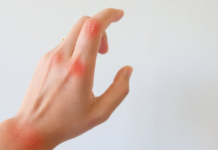Necrotizing Fasciitis is a serious condition that can cause life-threatening problems. It can be challenging to know what treatment options you have. Fortunately, you can learn a lot about the symptoms and signs of the disease and how to treat it. Thankfully, many helpful resources are available online to help you determine what you can do.
Table of Contents
Symptoms
Necrotizing fasciitis is a condition that occurs in the skin and can cause death. Various types of bacteria can cause it. Some of the more common causes include group A streptococcus and Clostridium.
Symptoms can vary greatly. People with this infection may have high fevers, delirium, weakness, and confusion. Other signs may include black scabs, blisters, and hardened, dry skin.
Treatments for necrotizing fasciitis are based on the type of bacteria infecting the skin. Antibiotics are used to kill bacteria and treat the infection. The infected area may also require reconstructive surgery.
If you suspect you have necrotizing fasciitis, visit your doctor immediately. Your healthcare provider will complete a physical examination and suggest several tests. An imaging study such as CT or MRI can help make the diagnosis.
Once you have a diagnosis, your medical team will work to care for your wound. Wounds should be cleaned with soap and water. Dressings should be changed frequently. Depending on the severity of the disease, you may need skin grafting.
Diagnosis
Necrotizing fasciitis is a severe infection that is often fatal. It causes severe pain and swelling. It usually affects the body’s soft tissues and can be difficult to diagnose.
The infection usually progresses rapidly. During the early stages, the patient might not have any symptoms. However, it is important to get an early diagnosis. This will help prevent the disease’s spread and stop it before it becomes fatal.
A positive tissue culture can confirm the diagnosis. Various tests are performed to evaluate the severity of the infection. These include C-Reactive Protein, electrolytes, and ECG. If these tests are positive, the doctor can diagnose necrotizing fasciitis.
Imaging is also helpful in diagnosing the condition. X-rays can reveal the presence of gas, as well as bullae, which are thick, watery, and grey pus-like tissue. In addition, a biopsy of the affected area can also be done.
Because of the seriousness of the infection, early treatment is crucial. Antibiotics are usually the first line of defense. Surgery is often necessary to remove dead tissues.
Treatment
Necrotizing fasciitis is an infection that affects the skin, often from bacteria. It is scarce but may be fatal. Affected patients have a fever, malaise, and severe pain.
The first line of defense against necrotizing fasciitis is surgery. Surgeons will remove the infected tissue to stop the disease from spreading. Survivors may need multiple surgeries to correct the disease, and limb amputations are common. Some survivors will also require skin grafting to repair the damage.
To prevent necrotizing fasciitis, it is important to clean wounds thoroughly. Use soap and water to wash away dirt, and change bandages regularly. Leaving open wounds untreated is a major risk factor for this condition.
Because of the high mortality rate of this illness, early diagnosis and treatment are crucial. Early intervention can significantly improve the prognosis of the patient.
Treatment of this condition is usually a combination of antibiotics and surgical debridement. Antibiotics help to control the infection at its source. Surgical debridement removes the dead tissue but does not heal the wound.
Laboratory risk indicators
Necrotizing fasciitis (NF) is a life-threatening bacterial skin infection that can cause sepsis. This condition is particularly deadly when not treated quickly and has a mortality rate of up to 50%. Although surgical intervention is usually required to treat necrotizing fasciitis, early detection and diagnostic scoring can prevent marked morbidity and mortality.
A number of laboratory risk indicators are being used to facilitate early diagnosis and treatment of necrotizing fasciitis. These measures can help to distinguish NF from less lethal mimics. The LRINEC score is one such tool. It was developed to identify patients who are at higher risk for NF.
LREC is a simple, non-invasive measure of the severity of infection. It includes several factors, such as serum sodium, hemoglobin, and creatinine. A high score suggests the presence of a high risk of NF.
A recent study has shown that the LRINEC score can be useful in diagnosing necrotizing fasciitis. However, the relationship between the score and the disease outcomes remains unknown.
Clinical features such as pain and swelling can help confirm a necrotizing fasciitis diagnosis. The use of an LRINEC score in conjunction with these factors can aid in early diagnosis and rapid empiric therapy.
Mortality rate
An uncommon, potentially fatal skin and fascia infection is known as necrotizing fasciitis. The perineum, muscles, subcutaneous tissues, and lower extremities are typically affected by the illness. These terms describe it: “hot,” “tender,” and “erythematous.”
This is an inflammatory infection that several pathogens may cause. It is characterized by rapidly progressive soft tissue necrosis. A small cut in the skin can be the source of this infection.
Most cases of necrotizing fasciitis occur in patients over the age of 65. Because of the rapid progression of the disease, it is essential to seek treatment early. Patients also require aggressive fluid resuscitation.
The bacteria Group A streptococcus (GAS) is responsible for an invasive kind of necrotizing fasciitis. Even though there is no vaccination to prevent GAS, proper wound care can.
According to estimates, there are 1.1 to 1.4 instances of necrotizing fasciitis per 100,000 person-years in the Netherlands. Despite having a low frequency, prompt diagnosis is frequently challenging due to the variety of presentations.
To increase the effectiveness of antibiotic therapy for necrotizing fasciitis, physicians should treat the infection with a combination of broad-spectrum intravenous antibiotics. In addition, aggressive surgical debridement of necrotic tissue is used.




